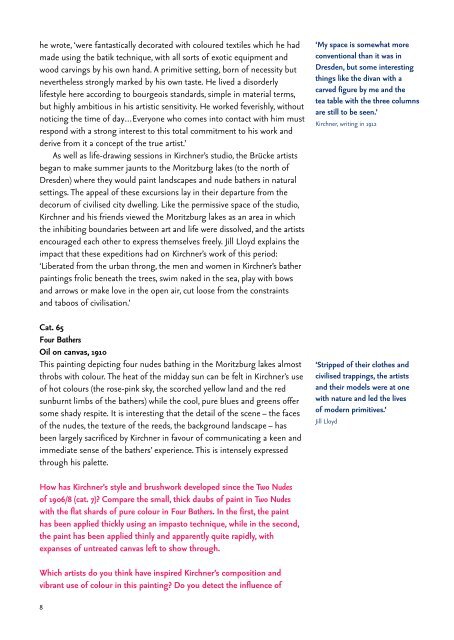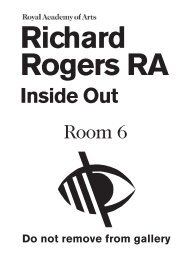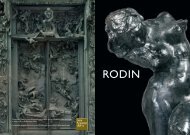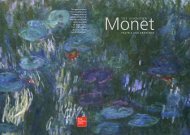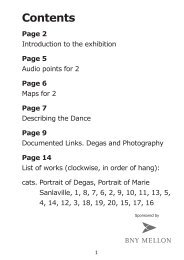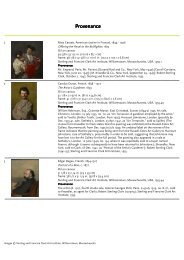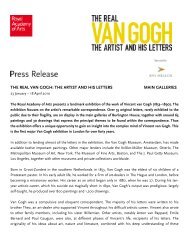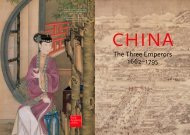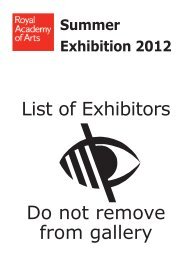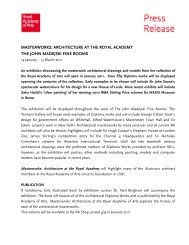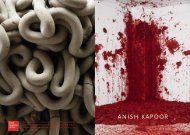KIRCHNER - Royal Academy of Arts
KIRCHNER - Royal Academy of Arts
KIRCHNER - Royal Academy of Arts
Create successful ePaper yourself
Turn your PDF publications into a flip-book with our unique Google optimized e-Paper software.
he wrote, ‘were fantastically decorated with coloured textiles which he had<br />
made using the batik technique, with all sorts <strong>of</strong> exotic equipment and<br />
wood carvings by his own hand. A primitive setting, born <strong>of</strong> necessity but<br />
nevertheless strongly marked by his own taste. He lived a disorderly<br />
lifestyle here according to bourgeois standards, simple in material terms,<br />
but highly ambitious in his artistic sensitivity. He worked feverishly, without<br />
noticing the time <strong>of</strong> day…Everyone who comes into contact with him must<br />
respond with a strong interest to this total commitment to his work and<br />
derive from it a concept <strong>of</strong> the true artist.’<br />
As well as life-drawing sessions in Kirchner’s studio, the Brücke artists<br />
began to make summer jaunts to the Moritzburg lakes (to the north <strong>of</strong><br />
Dresden) where they would paint landscapes and nude bathers in natural<br />
settings. The appeal <strong>of</strong> these excursions lay in their departure from the<br />
decorum <strong>of</strong> civilised city dwelling. Like the permissive space <strong>of</strong> the studio,<br />
Kirchner and his friends viewed the Moritzburg lakes as an area in which<br />
the inhibiting boundaries between art and life were dissolved, and the artists<br />
encouraged each other to express themselves freely. Jill Lloyd explains the<br />
impact that these expeditions had on Kirchner’s work <strong>of</strong> this period:<br />
‘Liberated from the urban throng, the men and women in Kirchner’s bather<br />
paintings frolic beneath the trees, swim naked in the sea, play with bows<br />
and arrows or make love in the open air, cut loose from the constraints<br />
and taboos <strong>of</strong> civilisation.’<br />
Cat. 65<br />
Four Bathers<br />
Oil on canvas, 1910<br />
This painting depicting four nudes bathing in the Moritzburg lakes almost<br />
throbs with colour. The heat <strong>of</strong> the midday sun can be felt in Kirchner’s use<br />
<strong>of</strong> hot colours (the rose-pink sky, the scorched yellow land and the red<br />
sunburnt limbs <strong>of</strong> the bathers) while the cool, pure blues and greens <strong>of</strong>fer<br />
some shady respite. It is interesting that the detail <strong>of</strong> the scene – the faces<br />
<strong>of</strong> the nudes, the texture <strong>of</strong> the reeds, the background landscape – has<br />
been largely sacrificed by Kirchner in favour <strong>of</strong> communicating a keen and<br />
immediate sense <strong>of</strong> the bathers’ experience. This is intensely expressed<br />
through his palette.<br />
How has Kirchner’s style and brushwork developed since the Two Nudes<br />
<strong>of</strong> 1906/8 (cat. 7)? Compare the small, thick daubs <strong>of</strong> paint in Two Nudes<br />
with the flat shards <strong>of</strong> pure colour in Four Bathers. In the first, the paint<br />
has been applied thickly using an impasto technique, while in the second,<br />
the paint has been applied thinly and apparently quite rapidly, with<br />
expanses <strong>of</strong> untreated canvas left to show through.<br />
Which artists do you think have inspired Kirchner’s composition and<br />
vibrant use <strong>of</strong> colour in this painting? Do you detect the influence <strong>of</strong><br />
8<br />
‘My space is somewhat more<br />
conventional than it was in<br />
Dresden, but some interesting<br />
things like the divan with a<br />
carved figure by me and the<br />
tea table with the three columns<br />
are still to be seen.’<br />
Kirchner, writing in 1912<br />
‘Stripped <strong>of</strong> their clothes and<br />
civilised trappings, the artists<br />
and their models were at one<br />
with nature and led the lives<br />
<strong>of</strong> modern primitives.’<br />
Jill Lloyd


